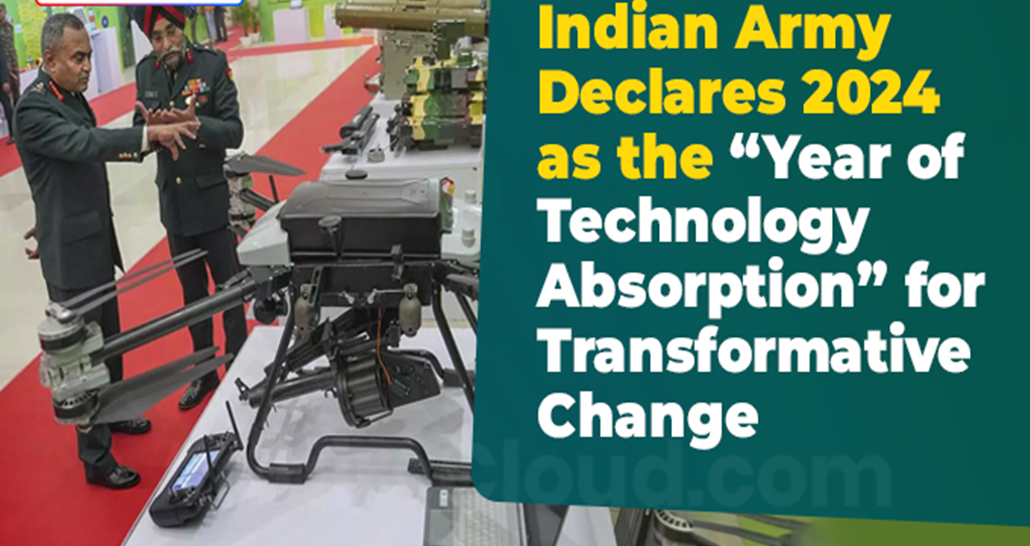MARCHING AHEAD WITH TECHNOLOGY ABSORPTION
Syllabus:
GS-III:
- Achievements of Indians in Science & Technology; Indigenization of Technology and Developing New Technology.
- Awareness in the fields of IT, Space, Computers, Robotics, Nano-technology, Bio-technology and issues relating to Intellectual Property Rights.
Why in the news?
Indian Army’s ‘Year of Technology Absorption’ aims at embracing disruptive tech like AI, drones, highlighting strategic importance.
source:slidemodel
About the Year of Technology Absorption in the Indian Army:
- The Indian Army’s focus on technology absorption in 2024 underlines its commitment to staying ahead in warfare.
- Atmanirbharta serves as the guiding principle, emphasising self-reliance.
- Scope of Absorption:
- Emphasis on disruptive technology (DT) like artificial intelligence, drones, robotics, etc.
- Strategic importance highlighted due to the decisive role of technology in future conflicts.
- Military Absorption Process:
- Involves acquisition, adaptation, and integration into existing structures.
- Complementary integration of DTs with existing platforms essential for practical use.
- Adapting to New Conditions:
- Importance of operational and tactical adaptations in addition to technological advancements.
- Historical tactics of dispersion, cover, and concealment remain relevant in modern warfare.
- Survivability and Dispersal:
- Requirement for adaptable tactics to enhance survivability.
- Dispersal of tanks and infantry coupled with electronic warfare capabilities crucial for operational success.
- Lethality and Outcome Determinants:
- Technological advancements enhance lethality but are not the sole determinants of outcomes.
- Realised lethality in recent conflicts akin to earlier eras, emphasising the multifaceted nature of warfare.
- Planning for the Future:
- Need to integrate technology attributes into future planning.
- Acknowledgment of vulnerabilities and sensitivities crucial for effective utilisation of technology.
- Unit-level Integration:
- Democratisation of technology utilisation necessary at the grassroots level.
- Macro-level aspects like organisational restructuring and human resource management vital for effective absorption.
| What is Disruptive technology?
Disruptive technology refers to innovations that fundamentally alter industries and markets by displacing existing products, services, or processes It displaces existing products, services, or processes. Leads to significant shifts in consumer behaviour. Reshapes economic landscapes. Examples of Disruptive technology:
Key Disruptive technology trends :
|
Understanding emerging technologies in Indian defence sector:
- Chanakya Defence Dialogue (2023): Held to discuss contemporary issues including emerging technologies to enhance national and regional security.
- Integrated Unmanned Roadmap: Comprehensive plan in Indian Navy for standardised development and deployment of unmanned systems to achieve interoperability and jointness.
- Project Swavlamban: Initiative promoting self-reliance in defence by encouraging indigenous development of equipment and technology.
- AIDef (Artificial Intelligence in Defence): Symposium showcasing AI-enabled solutions for defence, facilitated by Defence AI Council and Defence AI Project Agency.
- Defence Cyber Agency (2018): Established to handle cybersecurity threats and develop cyber warfare doctrine.
- Defence Space Agency: Responsible for operating space warfare and satellite intelligence assets, ensuring India’s capabilities in space defence.
- iDEX (Innovations for Defence Excellence):Launched in 2018 to foster innovation and technology development in Defence and Aerospace sectors.
- India Semiconductor Mission:
- Launched in 2021 with a Rs76,000 crore financial outlay under the Ministry of Electronics and IT (MeitY).
- Aims to develop a sustainable semiconductor and display ecosystem in the country.
- Provides financial support to companies investing in semiconductor, display manufacturing, and design ecosystems.
Challanges:
- Need for cautious optimism despite technological advancements.
- Case study of Russia-Ukraine war highlights the importance of traditional methodologies alongside technology.
- Sustaining technology absorption requires nuanced understanding and continual adaptation.
- Despite increasing awareness of legal and ethical implications, security concerns take precedence, leading to confidentiality and restricted circulation of information and documents.
Way Forward:
- Focus areas of the debate include artificial intelligence, cyber weapons, and drones, but broader discussions should encompass space and hypersonic weapons, directed-energy weapons/lasers, and photonic weapons.
- Implement policies to incentivize R&D investment in emerging tech such as quantum computing and AI, fostering public-privatecollaboration.
- Balancing security imperatives with ethical and legal considerations is essential to promote accountability and prevent unintended consequences in the use of military EDTs.
- Military emerging disruptive technologies (EDTs) rapidly alter existing technologies and can revolutionise governmental structures, economies, and international security.
Conclusion:
The Indian Army’s focus on technology absorption signifies a proactive approach towards modernising warfare.Sustained efforts, coupled with adaptive strategies, are essential to meet future challenges effectively.
Source:
https://www.thehindu.com/opinion/op-ed/marching-ahead-with-technology-absorption/article68043715.ece
Mains Practice Question:
Discuss the significance of the ‘Year of Technology Absorption’ observed by the Indian Army in 2024. How does the absorption of disruptive technologies contribute to India’s military strategy and preparedness in the context of evolving warfare? Examine the challenges and nuances associated with integrating disruptive technologies into existing military structures and operations.




